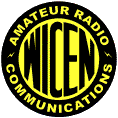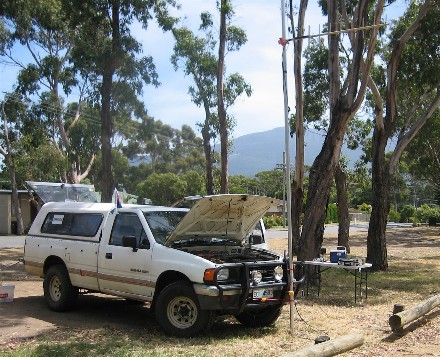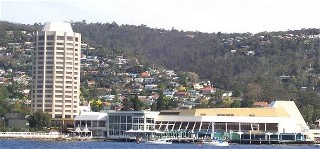

 |
 |
WICEN Interest Re-Aroused
|
WICEN in southern Tasmania has a long association with motor sport, especially Targa Tasmania and, in earlier years, the Australian Rally championship heat under its various sponsor related guises. Tasmania’s loss of the championship heat was also sadly missed by WICEN. The differences between the two events, from WICEN’s perspective, was that Targa involved radio and repeater deployment and operation using Targa owned equipment, whereas the championship task was to design, establish and operate a whole system. Rallies normally have at least three radio networks – Stage, Command and Results. WICEN’s role on Targa Tasmania involved Stage nets. On the championship event it had been Command or Results. WICEN’s interest dwindled.Discussion with Targa’s Communications manager, Ron Brown VK7ZRO, led to Ron having a think about something with a bit of a technical challenge for WICEN to get its teeth into. Ron is well known for at least two of his attributes, both associated with his head. The first is that lots of it is visible. The second, more important, is that Ron does a fair bit of thinking, usually with interesting outcomes.
In
2009, a new event was introduced - Targa Wrest Point - a sort of mini Targa,
run only in the south of the State over two days, versus the five days of
Targa Tasmania. The first event in 2009 suffered some problems which were designed out for 2010. One of the changes was the use of one stretch of road four times,
twice in each direction. This road leads from Geeveston in the Huon Valley to the Tahune Airwalk, a
spectacular tree top height walk way in the deep and winding Huon River
valley. The stages Starts/Finishes were almost at the Airwalk a very difficult location for
radio communications. The Airwalk visitor station has satellite phone communications for voice and
data but this was only available for the rally in case of dire emergency. The challenge for Ron was getting reliable communications between
there and Rally Command at Wrest Point Casino, back in Hobart. Solution? Come up with an
outline plan and call in Tasmania (South)
to develop and implement it.
Fixing two problems at the same time, comms and WICEN’s
dwindling interest. Ron had found a good, high repeater location in 2009. A new logging road to an elevation of 555 metres ended at a nice level platform with astounding outlooks in the requisite directions. This gave a good start but still did not provide comms directly to the stages starts and finishes , nor over a 300 metre range of hills 53 kilometres distant and on to Rally Command at sea level, a further 3 kilometres away. This gave a total path from the stages to Command of 63 kilometres. Solutions:
Command - Voice
Results – Data (files containing each stage’s start and finish data)i> Packet Station located across the river to; Packet station located at the high point. Transfer to Telstra Next G wireless broadband
The
next link was on the hill top, known as Arve 34C, the name of the logging
coupe. A Honda 1KVA inverter
generator powered this site.
Here was a VHF repeater for Command voice comms (Tx Phillips FM815, Rx
Phillips PRM80), 6m mast and six element yagi, aimed towards Hobart, and
another Kenwood TM-D710A with Diamond X50 at 6 metres as the second packet
station. A notebook PC received
the files which were then attached to emails despatched to Results in Rally
Command at Wrest Point casino.
Connection to the Telstra Next G network was achieved via a Telstra wireless
link service and a Phil VK7JJ designed eight element yagi (www.perite.com/vk7jj/NextGYagi.htm). WICEN also established the Stage Net 80MHz repeater at this location 

The system terminus in Wrest Point Casino is almost RF impenetrable, so a
tripod mounted 6 element yagi at the front door was Heliax connected to an
Icom IC-208H in the room being used as rally Command centre.
|
|
|
The south east Amateur repeater network provided good liaison channels via VK7RTC on UHF and the VK7 RBI, RHT, RAD linked system on VHF. Mobile phones were also used. The Airwalk location could not access any of these so any liaison traffic was passed via the Arve 34C station. The task was completed successfully, despite a few early pre rally start hiccups. Lesson learned that although each of the sections was tested prior to the event and worked successfully, linking throughout caused new issues to arise which needed to be fixed on the run. Logistics precluded a full system test on site. In future we will test the paths on site, but also establish a facsimile of the full system across a ‘paddock’ to indicate any trouble points.
|
|